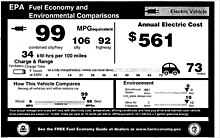
Fuel efficiency is a form of thermal efficiency, meaning the ratio of effort to result of a process that converts chemical potential energy contained in a carrier (fuel) into kinetic energy or work. Overall fuel efficiency may vary per device, which in turn may vary per application, and this spectrum of variance is often illustrated as a continuous energy profile. Non-transportation applications, such as industry, benefit from increased fuel efficiency, especially fossil fuel power plants or industries dealing with combustion, such as ammonia production during the Haber process.
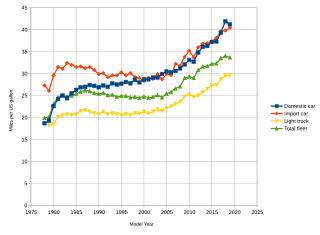
Corporate average fuel economy (CAFE) standards are regulations in the United States, first enacted by the United States Congress in 1975, after the 1973–74 Arab Oil Embargo, to improve the average fuel economy of cars and light trucks produced for sale in the United States. More recently, efficiency standards were developed and implemented for heavy-duty pickup trucks and commercial medium-duty and heavy-duty vehicles.

The Toyota RAV4 EV is an all-electric version of the popular RAV4 SUV produced by Toyota until 2014. Two generations of the EV model were sold in California, and to fleets elsewhere in the US, with a gap of almost ten years between them.

The Ford Fusion Hybrid is a gasoline-electric hybrid powered version of the mid-sized Ford Fusion sedan manufactured and marketed by Ford, which had two generations. A plug-in hybrid version, the Ford Fusion Energi, was released in the U.S. in February 2013. The last model year for all Ford Fusions was 2020.

The Ford C-Max is a car produced by the Ford Motor Company from 2003 to 2019. It has a five-door compact multi-purpose vehicle (MPV) design. The Ford Grand C-Max has a longer wheelbase.

A green vehicle, clean vehicle, eco-friendly vehicle or environmentally friendly vehicle is a road motor vehicle that produces less harmful impacts to the environment than comparable conventional internal combustion engine vehicles running on gasoline or diesel, or one that uses certain alternative fuels. Presently, in some countries the term is used for any vehicle complying or surpassing the more stringent European emission standards, or California's zero-emissions vehicle standards, or the low-carbon fuel standards enacted in several countries.
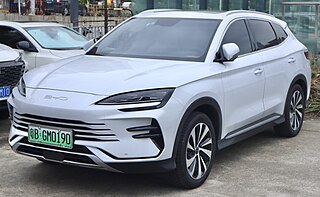
A plug-in hybrid electric vehicle (PHEV) or simply plug-in hybrid is a type of hybrid electric vehicle equipped with a rechargeable battery pack that can be directly replenished via a charging cable plugged into an external electric power source, in addition to charging internally by its on-board internal combustion engine-powered generator. While PHEVs are predominantly passenger cars, there are also plug-in hybrid variants of sports cars, commercial vehicles, vans, utility trucks, buses, trains, motorcycles, mopeds, military vehicles and boats.

The Honda Clarity is a nameplate used by Honda on alternative fuel vehicles. It was initially used only on hydrogen fuel-cell electric vehicles such as the 2008 Honda FCX Clarity, but in 2017 the nameplate was expanded to include the battery-electric Honda Clarity Electric and the plug-in hybrid electric Honda Clarity Plug-in Hybrid, in addition to the next generation Honda Clarity Fuel Cell. Clarity production ended in August 2021 with US leases for the fuel cell variant continuing through to 2022.
Gasoline gallon equivalent (GGE) or gasoline-equivalent gallon (GEG) is the amount of an alternative fuel it takes to equal the energy content of one liquid gallon of gasoline. GGE allows consumers to compare the energy content of competing fuels against a commonly known fuel, namely gasoline.
Blended mode is a charge-depleting mode of operation for plug-in hybrid electric vehicles (PHEVs) in which most of the motive energy is supplied by the battery pack but supplemented by the internal combustion engine (ICE). In contrast, all-electric or battery electric vehicles use only the electricity provided by the battery pack as their sole source of energy in a charge-depleting manner. Both types of advanced technology vehicles use regenerative brakes to recapture kinetic energy that should not be considered a fuel source but rather an efficiency aspect of these types of electric vehicle powertrains not found in traditional internal combustion engine vehicles.

The fuel economy of an automobile relates to the distance traveled by a vehicle and the amount of fuel consumed. Consumption can be expressed in terms of the volume of fuel to travel a distance, or the distance traveled per unit volume of fuel consumed. Since fuel consumption of vehicles is a significant factor in air pollution, and since the importation of motor fuel can be a large part of a nation's foreign trade, many countries impose requirements for fuel economy.

The Chevrolet Volt is a plug-in hybrid and extended-range electric vehicle car that was manufactured by General Motors, and also marketed in rebadged variants as the Holden Volt in Australia and New Zealand and the Buick Velite 5 in China, and with a different fascia as the Vauxhall Ampera in the United Kingdom and as the Opel Ampera in the remainder of Europe. Volt production ended in February 2019.

Miles per gallon gasoline equivalent is a measure of the average distance traveled per unit of energy consumed. MPGe is used by the United States Environmental Protection Agency (EPA) to compare energy consumption of alternative fuel vehicles, plug-in electric vehicles and other advanced technology vehicles with the energy consumption of conventional internal combustion vehicles rated in miles per U.S. gallon.

The adoption of plug-in electric vehicles in the United States is supported by the American federal government, and several states and local governments.
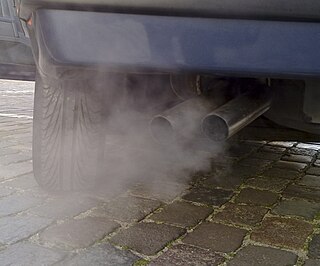
Mobile source air pollution includes any air pollution emitted by motor vehicles, airplanes, locomotives, and other engines and equipment that can be moved from one location to another. Many of these pollutants contribute to environmental degradation and have negative effects on human health. To prevent unnecessary damage to human health and the environment, environmental regulatory agencies such as the U.S. Environmental Protection Agency have established policies to minimize air pollution from mobile sources. Similar agencies exist at the state level. Due to the large number of mobile sources of air pollution, and their ability to move from one location to another, mobile sources are regulated differently from stationary sources, such as power plants. Instead of monitoring individual emitters, such as an individual vehicle, mobile sources are often regulated more broadly through design and fuel standards. Examples of this include corporate average fuel economy standards and laws that ban leaded gasoline in the United States. The increase in the number of motor vehicles driven in the U.S. has made efforts to limit mobile source pollution challenging. As a result, there have been a number of different regulatory instruments implemented to reach the desired emissions goals.
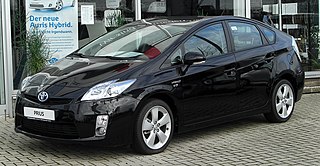
The Hybrid Scorecard was created by the Union of Concerned Scientists (UCS) to give consumers a comprehensive comparison of hybrid electric vehicles available in the U.S. market. The UCS Hybrid Scorecard ratings take into considerations fuel economy as rated by the U.S. Environmental Protection Agency (EPA); the environmental benefits as compared to its similar or closest conventional internal combustion engine counterpart; how cost-effectively a particular hybrid achieves its environmental performance; and premium features that are bundled on a hybrid as standard equipment raising its purchase price.

The long tailpipe is an argument stating that usage of electric vehicles does not always result in fewer emissions compared to those from non-electric vehicles. While the argument acknowledges that plug-in electric vehicles operating in all-electric mode have no greenhouse gas emissions from the onboard source of power, it claims that these emissions are shifted from the vehicle tailpipe to the location of the electrical generation plants. From the point of view of a well-to-wheel assessment, the extent of the actual carbon footprint depends on the fuel and technology used for electricity generation, as well as the impact of additional electricity demand on the phase-out of fossil fuel power plants.

The second generation Chevrolet Volt is a plug-in hybrid electric compact car produced by General Motors under the Chevrolet brand. It debuted at the 2015 North American International Auto Show to replace the original Volt, on sale since 2010. Retail deliveries as a 2016 model year began in October 2015 in the U.S. and Canada, and it was released in Mexico in December 2015. Availability of the 2016 model was limited to California and the other 10 states that follow California's zero emission vehicle regulations. It went on sale as a 2017 model year in the rest of the U.S. in February 2016. Volt production ended on February 15, 2019.
The following table compares official EPA ratings for fuel economy for series production all-electric passenger vehicles rated by the EPA for model years 2015, 2016, 2017, and 2023 versus the model year 2016 vehicles that were rated the most efficient by the EPA with plug-in hybrid drivetrains, gasoline-electric hybrid drivetrains, and the average new vehicle for that model year, which has a fuel economy of 25 mpg‑US.
The following table compares EPA's estimated out-of-pocket fuel costs and fuel economy ratings of serial production plug-in hybrid electric vehicles rated by EPA as of January 2017 expressed in miles per gallon gasoline equivalent (mpg-e), versus the most fuel efficient gasoline-electric hybrid car, the 2016 Toyota Prius Eco, rated 56 mpg‑US, and EPA's average new 2016 vehicle, which has a fuel economy of 25 mpg‑US. The table also shows the fuel efficiency for plug-in hybrids in all-electric mode expressed as KWh/100 mile, the metric used by EPA to rate electric cars before November 2010.




